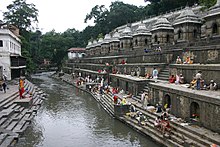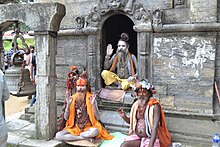Pashupatinath



Pashupatinath (also Pashu Pati Nath or Pashupati Nath , literally: "Lord of life" or "Lord of all living things", nepali : पशुपतिनाथ Paṣupatināth ) near Kathmandu in Nepal is one of the most important temple sites of Hinduism . For many Shivaites the temple is one of the most important places of worship of Shiva and for some is one of the Jyotirlingas . Thousands of Hindus who travel from far and wide celebrate the Shivaratri festival here every spring . The sanctuary was with the other attractions of the Kathmandu Valley in the year 1979 as a World Heritage of UNESCO classified.
location
The temple district of Pashupatinath is located on the banks of the Bagmati River, which flows into the Ganges over the Koshi, approx. 4 km (driving distance) east of Kathmandu at an altitude of approx. 1315 m .
history
It is believed that there was a holy place here in pre-Christian times. The Pashupati Temple was first built in the 5th century and - after being destroyed in 1343 by Shamsuddin Ilyas Shah , the later founder of the Sultanate of Bengal - renewed under the Malla dynasty (1201–1769). During the earthquake in 2015 , some smaller side shrines collapsed or were damaged.
Shiva temple
Here Shiva is worshiped as Pashupati ("God of Life" - Pashu = "Life"). The actual temple is only accessible to Hindus , the outer temple area, however, can be entered by anyone. The temple forms a pagoda with two roof levels covered with gilded copper. The four entrance doors are clad with silver plates. In the cella ( garbhagriha ) inside the temple there is a four-faced Shiva lingam about 1.80 m high with a diameter of about 1.10 m. It may only be touched by four priests ( bhattas ), who must always come from the south of India; there are also numerous priests of lower rank ( bhandaris ) entrusted with auxiliary tasks .
Cremation of bodies on the Bagmati
The Bagmati divides the system into two large areas. On the right bank of the Bagmati are the Pashupatinath Temple and the cremation sites, the Arya Ghats (cremation sites of the higher castes) and the Surya Ghats (cremation sites of the lower castes). For many believers, this place has a special meaning as a place for the “last rites”: it is considered worthwhile to have one's corpse cremated here.
The corpse, usually wrapped in yellow cloths, is carried to the cremation sites, where a pyre is set up. Before cremation, the corpse is splashed with the water of the holy river or the feet are washed in the water. The corpse is then covered from above with damp straw. If the family can afford it, the precious, fragrant sandalwood is used for burning in addition to normal wood. The eldest son then walks around the pyre five times clockwise ( pradakshina ) , corresponding to the sacred number five, which in Hinduism represents the five elements earth, water, fire, wind and Akasha , the ether. Then he (alternatively the eldest daughter or a priest) lights the pyre near the head with a tuft of straw soaked in liquid butter ( ghee ). But other places on the pyre are also set on fire. The dead man's family and friends stay close while the body is cremated, while a man in a white robe with a stick repeatedly directs the pyre so that everything burns. The dead man's feet initially protrude a little over the pyre and are then pushed into the fire as the cremation progresses. After about four hours, the body is burned to ashes. The ashes and incompletely burned logs are pushed into the river. Unburned jewelry etc. is removed from the ashes beforehand.
Widow burning on the Bagmati
In earlier times the widow of a deceased sometimes followed her husband at the stake to death ( sati ) - more or less voluntarily . This practice, already handed down in Roman sources, has been forbidden since the 19th century.
See also
- Mandsaur , India
Web links
- Pashupatinath Temple - Photos + Info
- Pashupatinath Temple - Photos + Info
- Pashupatinath Temple - Info (English)
Individual evidence
- ↑ Entry on the website of the UNESCO World Heritage Center ( English and French ).
- ↑ Pashupatinath Temple - Map with elevation information
- ^ Pashupatinath - newspaper article in the Deccan Herald
Coordinates: 27 ° 42 ′ 37.8 ″ N , 85 ° 20 ′ 55.1 ″ E


